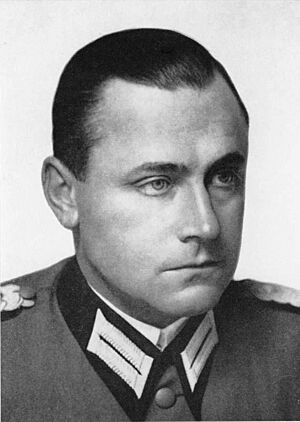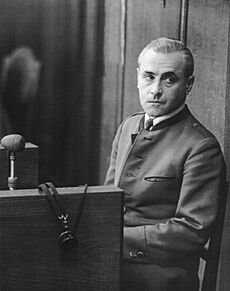Walter Warlimont facts for kids
Quick facts for kids
Walter Warlimont
|
|
|---|---|

Warlimont in 1939
|
|
| Deputy Chief of the Operations Staff of the Armed Forces High Command |
|
| In office 1 September 1939 – 6 September 1944 |
|
| Leader | Alfred Jodl |
| Preceded by | Office established |
| Succeeded by | Horst Freiherr Treusch von Buttlar-Brandenfels |
| Personal details | |
| Born | 3 October 1894 Osnabrück, Province of Hanover, Kingdom of Prussia, German Empire |
| Died | 9 October 1976 (aged 82) Kreuth, Bavaria, West Germany |
| Spouse |
Anita von Kleydorff
(m. 1927) |
| Parents | Louis Warlimont (father) Anna Rinck (mother) |
| Military service | |
| Allegiance | |
| Branch/service | |
| Years of service | 1914–1945 |
| Rank | General of the Artillery |
| Battles/wars | World War I World War II |
Walter Warlimont (born October 3, 1894 – died October 9, 1976) was an important German military leader during World War II. He worked as a top planner for the German Armed Forces High Command (OKW). After the war, Warlimont was found guilty of war crimes in a special trial. He was sent to prison but was later released in 1954.
Contents
Early Life and Military Career
Walter Warlimont was born in Osnabrück, Germany. In June 1914, just before World War I began, he joined the army. He became a second lieutenant in an artillery unit.
During World War I, he served as an artillery officer. He fought in both France and Italy. After the war, he joined a group called the Freikorps.
Between the World Wars
In the years between World War I and World War II, Warlimont held different military jobs. In 1927, he worked for General Werner von Blomberg. Blomberg was the head of the Truppenamt, which was a secret German General Staff.
In 1929, Warlimont spent a year in the U.S. Army. He studied how America would get its industries ready for war. From 1930 to 1933, he worked on war planning for the German Defence Ministry. He became the head of this section in 1935.
In 1936, Warlimont went to Spain during the Spanish Civil War. He was sent by the German War Minister to help General Francisco Franco. Germany supported Franco's side in the war.
In 1937, Warlimont wrote a special plan. This plan suggested that all German armed forces should be under one leader. This leader would be Adolf Hitler. Hitler liked this idea and created the Oberkommando der Wehrmacht (High Command of the Armed Forces). Hitler became its supreme commander. Warlimont was rewarded for his idea. In 1939, he became the deputy to General Alfred Jodl. In 1938, he was promoted to colonel.
World War II Operations
In late 1938, Warlimont became a senior officer for General Wilhelm Keitel. From September 1939 to September 1944, he was the Deputy Chief of the Operations Staff. This staff was in charge of planning all major military actions. General Jodl was his boss.
Planning Invasions
In early 1939, Warlimont helped plan Germany's invasion of Poland. On September 1, 1939, Germany invaded Poland, starting World War II.
In 1940, he was promoted to Generalmajor. He helped plan the invasion of France. During the Battle of France, on June 14, 1940, Warlimont landed his personal plane in the center of Paris. In 1941, he helped plan the invasion of Russia. He was promoted to Generalleutnant in 1942.
Later War Years
In November 1942, Warlimont was briefly removed from his job. This happened because a junior officer made a mistake with a message. However, he was quickly called back to duty. He went to France to help plan the defense of French territories.
In February 1943, Warlimont traveled to Tunis. He met with General Erwin Rommel to discuss if Germany should leave North Africa.
In early 1944, Warlimont was promoted again. He became a General of the Artillery. He continued to brief Hitler almost every day about the war.
On D-Day, when the Allies invaded Normandy, France, Warlimont called Jodl. He asked for German tanks to be sent to fight the Allies. Jodl said they had to wait for Hitler to wake up. By the time Hitler approved, it was too late to stop the Allied invasion. The next day, Hitler sent Warlimont to check German defenses in Italy.
July 20th Plot and Retirement
On July 20, 1944, Warlimont was hurt in a bomb attack against Hitler. This happened during a war meeting. He had a mild head injury. Later that day, he told Field Marshal Günther von Kluge that Hitler was alive. This stopped Kluge from continuing a plan against Hitler. Even though Warlimont was wounded, some people wrongly thought he was part of the plot. He later received a special medal for being wounded in the attack.
On July 22, Warlimont went to France. He met with Field Marshal Rommel to talk about the difficult situation in Normandy.
Hitler later suspected Warlimont of being involved in the plot against him. Warlimont denied this. Due to dizzy spells from his injury, Warlimont asked to be transferred. He was moved to a special command pool and did not serve actively for the rest of the war.
Trial and Release
In October 1948, Walter Warlimont was put on trial. This was part of the Subsequent Nuremberg Trials held by the United States military. He was found guilty and sentenced to life in prison. One reason was his role in creating orders that led to harm against civilians and prisoners of war.
His sentence was later reviewed. In 1951, it was changed to 18 years. He was released from prison in June 1954.
Personal Life
Walter Warlimont was the son of Louis Warlimont and Anna Rinck. His parents were from Eupen, which is now part of Belgium. They moved to Osnabrück, Germany. His father was a bookseller.
In 1927, Walter Warlimont married Anita von Kleydorff. Her father was Franz Egenieff.
Warlimont wrote a book in 1962 called Inside Hitler's Headquarters 1939–1945. He died in 1976 in Kreuth, Germany.
See also
- Commando Order
- Commissar Order


